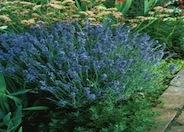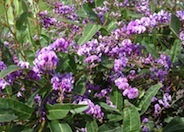
Common name:Sticky Monkey Flower
Botanical name:Mimulus aurantiacus
Sticky Monkey Flower is a drought tolerant evergreen shrub 4 ft. ft tall with numerous orangish/yellow flowers in spring and summer. It is a California native that attracts hummingbirds. This shrub can be found on the dry hills and canyon slopes in the Sierra Nevada foothills and the central Coast Ranges.
-Cornflower Farms

Common name:Blue Oat Grass
Botanical name:Helictotrichon sempervirens
The blue oat grass is a evergreen blue clumping grass that grows 12-18 in. tall and wide. Its showy flowers are 1-2 ft. above the foliage. This plant looks good alone as well as in mass plantings. The blue oat grass likes dry hill sides and is drought tolerant. -Cornflower Farms

Common name:Santa Barbara Daisy
Botanical name:Erigeron karvinskianus 'Profusion'
This herbacious perennial quickly grows to 1' tall and 3' wide. White daisy-like flowers with gold centers bloom heavily in spring and fall in the low desert but in higher elevations, bloomtime is only during the summer. The foliage is hairy and gray green. It does better in light shade if planted in the low desert. This plant attracts butterflies. It looks great in rock gardens, crevices, on walls, borders, containers, hanging baskets. It tolerates sand and wind; it does best with well draining, moist soil.

Common name:Lavender Lady English Lavender
Botanical name:Lavandula angustifolia 'Lavender Lady'
A well-developed woody base is apparent with this evergreen subshrub. Its leaves assume an obtuse form, and have a grey-green color above and a white tomentose shade below. It needs little water, full sun, and well drained soils. Strong lavender scent for perfumes and sachets.

Common name:Lilac Vine, Coral Pea
Botanical name:Hardenbergia violacea
Hardenbergia violacea rosea an evergreen shrubby vine. Leaves are usually undivided, 2-4 in. long. Flowers are lilac or rose and look like sweet peas.
The natural world works in cycles. Everything is changing form and moving from place to place in an endless energy exchange system. The leaves and twigs that fall to the ground, not to mention other life forms that might die, decompose and combine with water, air and minerals of the soil to create a medium for future plants.
Click in the green box for more information
Designer: Stephanie Morris
Photographer: GardenSoft
Incorporate compost 6" into your soil to retain water, reduce compaction, feed earthworms, and provide valuable nutrients to your plants.
Mulching and adding compost to soil can minimize evaporation and help soil absorb and store water.
Drip and other smart irrigation delivers water directly to roots, allowing no excess water for weeds.